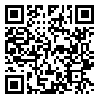Volume 21, Issue 2 (7-2021)
ijdld 2021, 21(2): 92-100 |
Back to browse issues page
Download citation:
BibTeX | RIS | EndNote | Medlars | ProCite | Reference Manager | RefWorks
Send citation to:



BibTeX | RIS | EndNote | Medlars | ProCite | Reference Manager | RefWorks
Send citation to:
Moshrefzadeh S, Ravaei B, Kozegar E. Diagnosis of Diabetes Using a Random Forest Algorithm. ijdld 2021; 21 (2) :92-100
URL: http://ijdld.tums.ac.ir/article-1-6034-en.html
URL: http://ijdld.tums.ac.ir/article-1-6034-en.html
1- ComputerEngineering, Faculty of Engineering, Yasouj University, Iran , sadeghmoshrefzadeh@yahoo.com
2- ComputerEngineering, Faculty of Engineering, Yasouj University, Iran
3- Computer Engineering, Faculty of Engineering, University of Guilan, Iran
2- ComputerEngineering, Faculty of Engineering, Yasouj University, Iran
3- Computer Engineering, Faculty of Engineering, University of Guilan, Iran
Abstract: (1962 Views)
Background: Diabetes is the fourth leading cause of death in the world. And because so many people around the world have the disease, or are at risk for it, diabetes can be called the disease of the century. Diabetes has devastating effects on the health of people in the community and if diagnosed late, it can cause irreparable damage to vision, kidneys, heart, arteries and so on. Therefore, it is necessary to have methods to diagnose this disease in the early stages. In this article, data mining is used to diagnose diabetes.
Methods: The main algorithm used in this paper is the random forest algorithm. To evaluate the efficiency of the proposed algorithm in diagnosing diabetes, a data set was used that included 768 samples (patients) and had 8 characteristics. Because the stochastic forest algorithm is a hybrid algorithm created from several decision trees, it achieves high accuracy in diagnosing diabetes.
Results: Using this algorithm, we were able to increase the accuracy of diabetes diagnosis to 99.86%.
Conclusion: Diabetes is the fourth leading cause of death in the world. Different algorithms have been used to diagnose this disease. We tried to use an algorithm that has a very high degree of accuracy compared to other algorithms for diagnosing this disease.
Methods: The main algorithm used in this paper is the random forest algorithm. To evaluate the efficiency of the proposed algorithm in diagnosing diabetes, a data set was used that included 768 samples (patients) and had 8 characteristics. Because the stochastic forest algorithm is a hybrid algorithm created from several decision trees, it achieves high accuracy in diagnosing diabetes.
Results: Using this algorithm, we were able to increase the accuracy of diabetes diagnosis to 99.86%.
Conclusion: Diabetes is the fourth leading cause of death in the world. Different algorithms have been used to diagnose this disease. We tried to use an algorithm that has a very high degree of accuracy compared to other algorithms for diagnosing this disease.
Type of Study: Research |
Subject:
Special
Received: 2021/01/16 | Accepted: 2021/08/26 | Published: 2021/07/1
Received: 2021/01/16 | Accepted: 2021/08/26 | Published: 2021/07/1
Send email to the article author
| Rights and permissions | |
 |
This work is licensed under a Creative Commons Attribution-NonCommercial 4.0 International License. |






